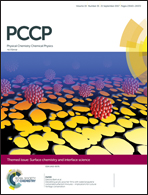Calix[n]arene-based polyradicals: enhancing ferromagnetism by avoiding edge effects†
Abstract
Through-bond interacting organic polyradicals, rendered by customizable capacities of the state-of-the-art synthetic routes, are ideal systems to investigate spin topologies. Relying on Rajca and co-workers’ synthetic efforts, hereby we investigate the role of borders in the stability of the high-spin ground state in a series of realistic linear and ring-like arylmethyl polyradical derivatives. We show that, compared to their linear counterpart, the absence of borders in a ring-like arrangement of arylmethyl radicals imposes a larger number of spin-alternation rule violations, which strongly stabilizes the high-spin ground state. In addition, the structural flexibility of the investigated compounds translates into the existence of various structural energy minima for which the ferromagnetic ground state is always maintained. In view of the present results we propose these rings as possible candidates for the development of enhanced high spin single molecule toroics.
![Graphical abstract: Calix[n]arene-based polyradicals: enhancing ferromagnetism by avoiding edge effects](/en/Image/Get?imageInfo.ImageType=GA&imageInfo.ImageIdentifier.ManuscriptID=C7CP04145D&imageInfo.ImageIdentifier.Year=2017)


 Please wait while we load your content...
Please wait while we load your content...